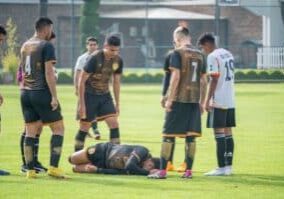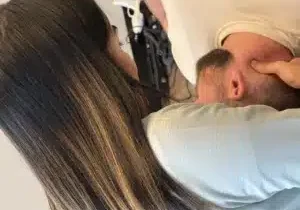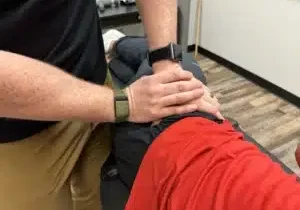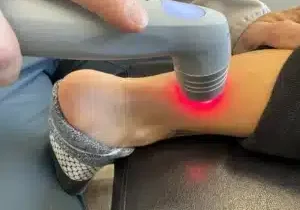Do you often experience a shooting pain that starts in your lower back and radiates down your leg? If so, you may be suffering from sciatica or maybe not. In order to understand what’s going on we have to start looking at what sciatica is and what causes it? It’s time to debunk the misconceptions surrounding this common ailment and understand its true causes.
Understanding Sciatica
Sciatica refers to the pain that occurs along the sciatic nerve, which runs from your lower back, through your hips, and down each leg. The pain typically affects only one side of your body and can range from mild discomfort to excruciating pain.
Contrary to popular belief, sciatica is not a condition in itself, but rather a symptom of an underlying problem. It is important to identify the root cause of sciatica in order to find appropriate treatment and relief.
Common Misconceptions about Sciatica
Misconception 1: Sciatica is caused by a slipped disc.
This is a common misconception. While a herniated or slipped disc can indeed compress the sciatic nerve and result in sciatica, there are other potential causes as well. It is important not to jump to conclusions and assume that a slipped disc is the only culprit.
Misconception 2: Only older adults can suffer from sciatica.
Sciatica can affect individuals of all ages, not just the elderly. In fact, it is often caused by lifestyle factors such as poor posture, sedentary behavior, and lack of exercise. Whether you’re a teenager or a senior citizen, you can be susceptible to sciatica if you lead an inactive lifestyle.
Misconception 3: Rest is the best solution for sciatica.
While rest can provide temporary relief, it is not a long-term solution for sciatica. In fact, prolonged rest may worsen the condition by causing muscle stiffness and weakening. Appropriate exercises and physical therapy are crucial for relieving pain and preventing future recurrences.
The True Causes of Sciatica
1. Herniated or Bulging Discs
A herniated or bulging disc occurs when the soft inner material of a spinal disc protrudes through the tough outer layer. This can compress the nearby sciatic nerve, causing pain and discomfort.
2. Spinal Stenosis
Spinal stenosis refers to the narrowing of the spinal canal, which can put pressure on the nerves, including the sciatic nerve. This condition is more common in older individuals and often leads to sciatic pain.
3. Piriformis Syndrome
The piriformis muscle, located in the buttocks, can sometimes irritate or compress the sciatic nerve. This condition is known as piriformis syndrome and often results from muscle imbalances and overuse.
4. Spondylolisthesis
Spondylolisthesis occurs when a vertebra slips out of its normal position and onto the vertebra below it. This can cause the sciatic nerve to become pinched, resulting in sciatica.
Seeking Relief at Head 2 Toe Clinic
Now that you understand the true causes of sciatica, it’s time to seek professional help. At Head 2 Toe Clinic, our team of experienced chiropractors and athletic trainers specialize in diagnosing and treating sciatica.
With personalized treatment plans tailored to your specific needs, we aim to provide long-term relief and prevent future episodes of sciatic pain. Our holistic approach combines manual therapies, targeted exercises, and education to address the root cause of your sciatica.
Don’t let sciatica control your life. Contact us today at Head 2 Toe Clinic and take the first step towards a pain-free future. Say goodbye to misconceptions and hello to effective sciatica treatment!
How Manual Therapy Can Be Your Key to Pain Alleviation and Overall Wellness
Discover the transformative power of manual therapy for pain alleviation and wellness in our blog ‘How Manual Therapy Can Be Your Key to Pain Alleviation and Overall Wellness’.
Read MoreThe Role of Chiropractic Care in Sports Injury Rehab: A Deep Dive
Explore the essential role of chiropractic care in sports injury rehab in our comprehensive blog ‘The Role of Chiropractic Care in Sports Injury Rehab: A Deep Dive’.
Read MoreHow Your Local Chiropractor Can Help You With Back and Neck Pain
Understanding back and neck pain Back and neck pain can be caused by poor posture, muscle strain, injury, or underlying health conditions. The pain may range from mild to severe and can affect your daily activities. Common symptoms include stiffness, muscle spasms, and limited range of motion. In some cases, the pain may radiate to…
Read MoreRehabilitation Services for Sports Injuries: A Comprehensive Guide
Understanding sports injuries and the need for rehabilitation services Injuries during sports are common and can affect athletes of all levels. Rehabilitation services play a crucial role in helping athletes recover from these injuries and get back to their peak performance. With the right guidance and treatment, athletes can regain strength, flexibility, and mobility, ultimately…
Read MoreUnderstanding Posture Therapy: Techniques and Benefits
What is posture therapy? Posture therapy involves exercises and techniques to improve your body alignment and position. It aims to correct postural imbalances and relieve pain and discomfort caused by poor posture. The therapy focuses on strengthening muscles and stretching tight areas to achieve proper alignment of the body. It can also include education on…
Read MoreThe Science Behind Foot Pain Therapy: Understanding the Basics
What causes foot pain? The most common cause of foot pain is wearing ill-fitting or unsupportive footwear. High heels and narrow toe boxes can put excessive pressure on the feet, leading to issues like bunions and corns. Flat feet or high arches can also contribute to foot pain because they affect the alignment and distribution…
Read More





